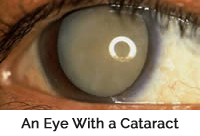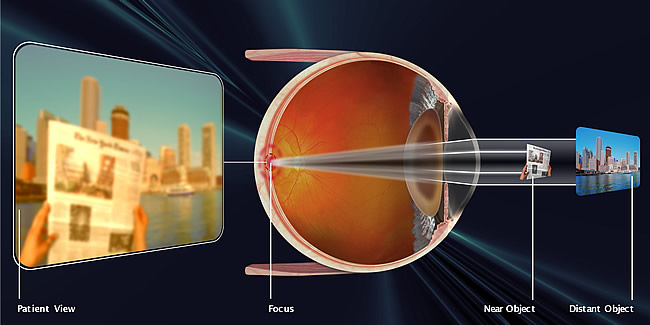Facts About Cataracts
 A cataract is a clouding of the eye’s lens that can cause vision problems. The most common type is related to aging. More than half of all Americans age 65 and older have a cataract.
A cataract is a clouding of the eye’s lens that can cause vision problems. The most common type is related to aging. More than half of all Americans age 65 and older have a cataract.
In the early stages, stronger lighting and eyeglasses may lessen vision problems caused by cataracts. At a certain point, however, surgery may be needed to improve vision. today cataract surgery is safe and very effective.
What is the Lens?
The lens is the part of the eye that helps focus light on the retina. The retina is the eye’s light-sensitive layer that sends visual signals to the brain. In the normal eye, light passes through the lens and gets focused on the retina. To help produce a sharp image, the lens must remain clear.
What is a Cataract?
The lens is made of mostly water and protein. The protein is arranged to let light pass through and focus on the retina. Sometimes some of the protein clumps together.
This can start to cloud small areas of the lens, blocking some light from reaching the retina and interfering with vision. This is a cataract.
In its early stages, a cataract may not cause a problem. The cloudiness may affect only a small part of the lens.
However, over time, the cataract may grow larger and cloud more of the lens, making it harder to see. Because less light reaches the retina, your vision may become dull or blurry.
A cataract won’t spread from one eye to another, although many people develop cataracts in both eyes.

What are the Symptoms?
The most common symptoms of a cataract are:
- Cloudy or blurry vision
- Problems with light. These can include headlights that seem too bright at night; glare from lamps or very bright sunlight; or a halo around lights
- Colors that seem faded
- Poor night vision
- Double or multiple visions (this symptom often goes away as the cataract grows)
- Frequent changes in your eyeglasses or contact lenses
These symptoms can also be a sign of other eye problems. If you have any of these symptoms, contact our office.

When a cataract is small, you may not notice any changes in your vision. Cataracts tend to grow slowly, so vision gets worse gradually.
Some people with a cataract find that their close-up vision suddenly improves, but this is temporary. Vision is likely to get worse again as the cataract grows.
What are the Different Types of Cataracts
- Age-related cataract: Most cataracts are related to aging
- Congenital cataract: Some babies are born with cataracts or develop them in childhood, often in both eyes. These cataracts may not affect vision. If they do, they may need to be removed
- Secondary cataract: Cataracts are more likely to develop in people who have certain other health problems, such as diabetes. Also, cataracts are sometimes linked to steroid use
- Traumatic cataract: Cataracts can develop soon after an eye injury, or years later

